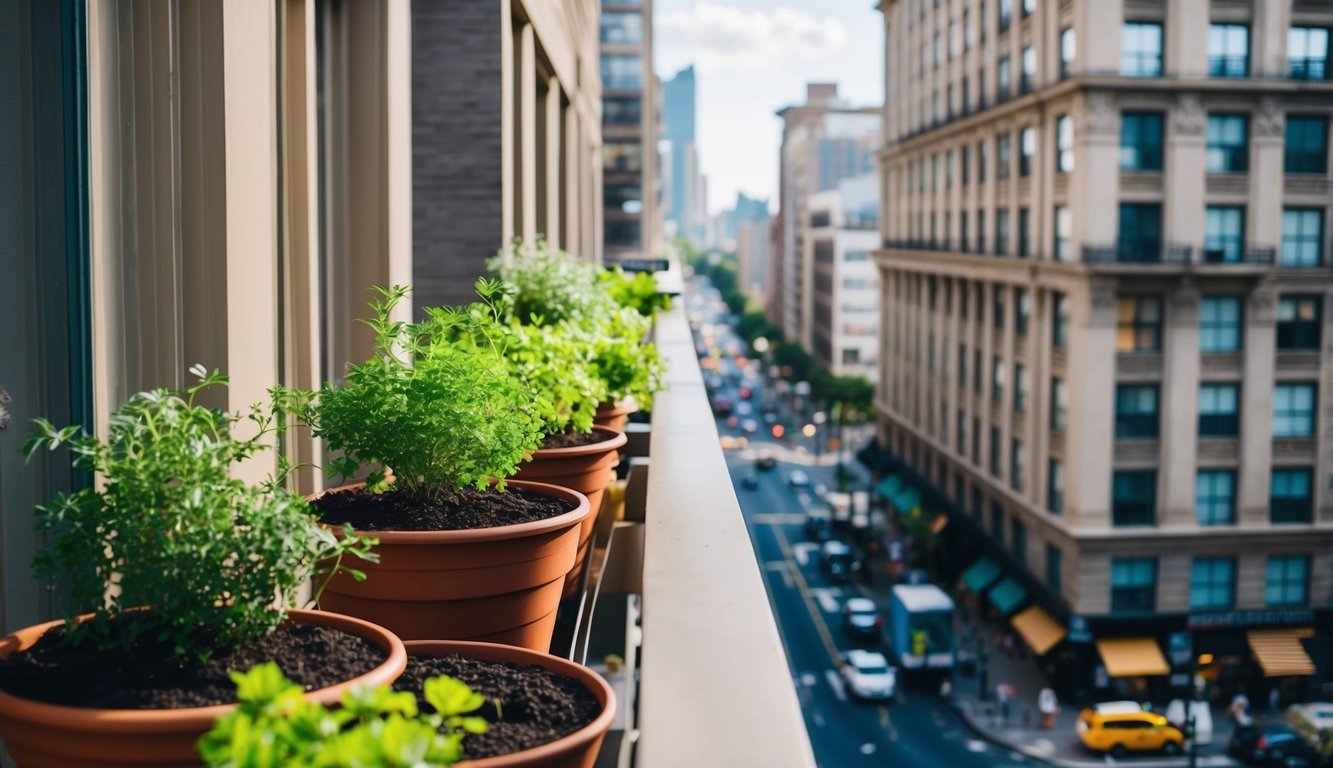Living in a city apartment can feel limiting when it comes to gardening, but creating a mini herb garden is easier than you might think. With just a few simple hacks, you can enjoy fresh herbs right from your kitchen, no matter how small your space is. The best part is that herbs like basil, mint, and parsley thrive in compact setups, making them perfect for apartment life.

In this article, I’ll share some creative strategies to maximize your indoor gardening experience.
Whether you have a windowsill, countertop, or even a small balcony, there are plenty of ways to cultivate a thriving herb garden that adds flavor to your meals and a touch of greenery to your home.
Use mason jars for a sleek look

I love using mason jars to create a stylish mini herb garden in my apartment.
They’re not only functional but also add a touch of charm to any space.
To get started, fill each jar with soil and add some small rocks at the bottom for drainage.
This prevents the roots from sitting in water, which is essential for healthy plants.
Mason jars come in various sizes, allowing you to mix and match for a unique arrangement.
You can place them on a windowsill where they can soak up the sunlight.
The clear glass allows you to see the roots and soil, which is aesthetically pleasing.
Plus, it makes it easier to know when to water your herbs.
For an extra touch, you can tie some twine or ribbon around the jars.
It makes them look even more appealing and fits perfectly with a rustic vibe.
2) Vertical planter rails maximize space

I love using vertical planter rails to get the most out of my limited apartment space.
These rails allow me to create a compact herb garden that doesn’t take up much room.
By mounting the rails on a wall, I can hang small pots filled with herbs.
It opens up my floor area while adding greenery to my living space.
Plus, it creates a unique visual appeal.
Caring for my herbs becomes easier, too.
With the plants at eye level, I can quickly assess their health and keep an eye on watering needs.
I also find that herbs benefit from better air circulation when they are elevated.
Setting up a vertical planter rail is simple.
You can use materials like untreated wood or metal brackets to build your setup.
Then, choose pots that suit your style and fit the herbs you want to grow.
With just a bit of creativity, these vertical rails can transform an empty wall into a thriving mini herb garden.
It’s a fun way to combine your love of cooking with your passion for gardening.
Choose herbs like basil and mint
When selecting herbs for my mini herb garden, I always turn to basil and mint.
These herbs not only add great flavor to my cooking, but they also thrive in small spaces.
Basil loves warmth and needs around 6-8 hours of sunlight each day, making it perfect for sunny windowsills.
I’ve found it grows well in small pots, and the fresh leaves are a delight in pasta dishes or salads.
Mint, on the other hand, is incredibly easy to grow.
It can be quite vigorous, so I recommend keeping it in its own pot to prevent it from overtaking other plants.
Mint also enjoys similar sunlight conditions as basil, which works perfectly for my herb garden setup.
Both herbs require regular watering but should be allowed to dry out a bit between sessions.
With these two choices, you can always have fresh, aromatic herbs ready to enhance your meals.
4) Self-watering pots for lazy days

I love using self-watering pots for my mini herb garden.
They take the hassle out of watering, especially on those busy days when I forget about my plants.
These pots often have a reservoir at the bottom that allows the soil to absorb water as needed.
It helps keep my herbs hydrated without being overwatered.
Watering wicks can also be used to draw moisture from the reservoir up into the soil.
I’ve found that repurposing items like old soda bottles works well too.
Just cut the bottom off, fill it with water, and invert it into the soil.
This method is simple and effective for smaller pots.
For a more polished look, I recommend purchasing self-watering containers.
They come in various designs, so you can choose one that fits your style.
Plus, they make maintaining your herb garden so much easier, allowing you to focus on cooking with your fresh herbs instead of worrying about daily watering.
Window sills are your best friends
I love using my window sills for growing herbs.
They provide a perfect spot that often gets plenty of sunlight.
The right amount of natural light can make a big difference for my little plants.
When selecting a windowsill, always aim for one that faces south.
This way, your herbs can soak up the sun for most of the day.
Sunlight is essential for healthy growth, especially in a city apartment.
I prefer using long, narrow planters that fit nicely along the ledge.
They make it easy to arrange a variety of herbs without taking up too much space.
I also ensure my planters are at least 6 to 8 inches deep for proper root development.
By keeping my herbs within reach, I enjoy the convenience of snipping fresh basil or parsley while cooking.
Plus, it adds a nice touch of greenery to my home.
Window sills truly offer a simple solution for urban gardening.
Choosing the Right Herbs
Selecting the right herbs for your mini garden is one of the most exciting parts of the process.
It involves balancing personal taste with some practical considerations that can influence your success.
Best Herbs for City Apartments
When I think about herbs for small spaces, a few favorites come to mind:
- Basil: Perfect for sunny windowsills, basil grows quickly and adds fresh flavor to many dishes.
- Chives: These hardy herbs thrive in various conditions and add a mild oniony taste to meals.
- Mint: Relatively easy to grow, mint can quickly take over if not contained. It’s refreshing for drinks and desserts.
- Parsley: Versatile and nutritious, parsley can grow in partial shade and enhance a variety of recipes.
These herbs are well-suited for indoor gardening and provide distinct flavors that can elevate your culinary creations.
Factors to Consider
A few key factors help you narrow down your herb choices:
-
Sunlight: Herbs like basil need plenty of direct sunlight, ideally 6-8 hours a day. If your apartment doesn’t get much light, you might opt for chives or parsley, which tolerate lower light.
-
Space: You have to think about how much room you’re working with. Growing herbs in containers or vertical gardens can maximize your limited space.
-
Culinary Preferences: Choosing herbs you frequently use in cooking keeps your garden relevant. If you love making fresh salsa, prioritize cilantro and jalapeño.
These considerations make choosing the right herbs not just an enjoyable task but a practical one that can lead to successful growing.
Setting Up Your Mini Herb Garden
Creating a mini herb garden in your apartment is an enjoyable project that adds both greenery and flavor to your space.
The key to success lies in thoughtful placement and the right containers and soil, ensuring your herbs thrive in limited areas.
Optimal Placement in Your Apartment
Finding the perfect spot for your mini herb garden is crucial.
Look for areas with ample sunlight, ideally a south-facing window that gets at least six hours of light daily.
Herbs like basil and mint adore the sun, while others like parsley can tolerate slightly less.
To maximize growth, use vertical spaces such as shelves and windowsills.
Hanging planters can also work wonders, using walls to your advantage.
Avoid cold drafts and excess moisture to ensure your herbs stay healthy and productive.
Containers and Soil Considerations
Selecting the right containers and soil makes a significant difference.
I prefer pots with drainage holes to prevent root rot.
The size matters too.
I often choose medium-sized pots that allow enough room for growth without taking up too much space.
For soil, a high-quality potting mix works best.
It retains moisture and provides essential nutrients.
Additionally, mixing in some perlite or vermiculite can enhance drainage.
I also make sure to avoid overwatering.
A little attention to moisture levels can keep my herbs happy and thriving.

